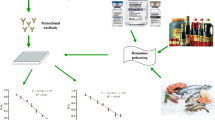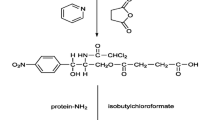Abstract
In recent years, various chemiluminescent clinical immunoassay kits have been widely applied to the detection of hormones. However, a kit for chloramphenicol (CAP) is often absent from most commercial product lists, even though it is important to control the levels of CAP residues in foodstuffs too. Therefore, we describe a simple, solid-phase chemiluminescence immunoassay (CLIA) for the measurement of CAP in foodstuffs. A rabbit anti-CAP IgG is passively adsorbed onto the walls of polypropylene plates. The labeled antigen is horseradish peroxidase (HRP) conjugate of CAP. Luminol solution is used as the substrate of HRP. The light yield is inversely proportional to the concentration of CAP. The method has a similar sensitivity (0.05 ng/ml), specificity, precision, and accuracy to a conventional enzyme immunoassay (EIA). The intra-assay and inter-assay CVs of ten samples were <8% and <20%, respectively, and the analytical recovery of the method was 87–100%. The experimental correlation coefficient of dilution was found to be 0.999 using milk supernatant as buffer. The detection limit for the method was 0.1–10 ng/ml, and it displayed good linearity.






Similar content being viewed by others
References
Ohno K-I, Arakawa H (1999) Development of novel high-sensitivity chemiluminescence assay for luminol using thiourea derivatives. Luminescence 14:355–360
Whitehead TP, Kricka LJ, Carter TJN, Thorpe GHG (1979) Analytical luminescence: its potential in the clinical laboratory. Clin Chem 25(9):1531–1546
Kim JB, Barnard GJ, Collins WP, Kohen F, Lindner HR, Eshhar Z (1982) Measurement of plasma estradiol-17β by solid-phase chemiluminescence immunoassay. Clin Chem 28(5):1120–1124
Javier Bagazgoitia F, Luis Garcia J, Ibarra JM, Patino R (1989) Chemiluminescent immunoassay (CLIA) for urinary albumin. J Biolumin Chemilum 3:169–174
Hubl W, Thorpe GHG, Hofmann F, Meissner D, Thiele HJ (1990) Enhanced cheniluminescent immunoassay for aldosterone. J Biolumin Chemilumin 5:49–52
Aoyagi S, Iwata T, Miyasaka T, Sakai K (2001) Determination of human serum albumin by chemiluminescence immunoassay with luminol using a platinum-immobilized flow-cell. Analytica Chimica Acta 436:103–108
Thorpe GHG, Kricka LJ (1986) Enhanced chemiluminescent reactions catalyzed by horseradish peroxidase. Methods Enzymol 133:331–353
Kricka LJ, Ji X (1995) 4-Phenylylboronic acid: a new type of enhancer for the horseradish peroxidase catalyzed chemiluminescent oxidation of luminol. J Biolumin Chemilumin 10:49–54
Kricka LJ, Cooper M, Ji X (1996) Synthesis and characterization of 4-iodophenylboronic acid: a new enhancer for the horseradish peroxidase-catalyzed chemiluminescent oxidation of luminol. Anal Biochem 240:119–125
Lynas L (1998) Screening for chloramphenicol residues in the tissues and fluids of treated cattle by the four-plate test, Charm II radioimmunoassay and Ridascreen CAP-Glucuronid enzyme immunoassay. Analyst 123:2773–2777
Liu Z-h (1995) Enzyme immunoassay for assaying chloramphenicol in animal foodstuff. Chin J Vet Drug 29(2):47–48
Dzgoev AB (1999) High-sensitivity assay for pesticide using a peroxidase as chemiluminescent label. Anal Chem 71:5258–5261
Wang C-J (1993) A sensitive enzyme immunoassay (EIA) for quantitation of the topical anti-inflammatory agent SCH 40120 in unectracted human plasma. J Pharm Biomed Anal 11(10):871–879
Xu CL (2003) A determination of chloramphenicol in animal foodstuff with enzyme immunoassay[P]. CN1389729A, 2003-1–8
Zhou DG, Fang H (2003) The evaluation of three kinds of chloramphenicol-ELISA kits. Chin J Vet Drug 37(9):28–31
Wang J (2002) A high stability chemiluminescence substrate and its determination[P]. CN1333464A, 2002-1–30
Iwata R, Ito H, Hayashi T, Sekine Y, Koyama N, Yamaki M (1995) Stable and general-purpose chemiluminescent detection system for horseradish peroxidase employing a thiazole compound enhancer and some additives. Anal Biochem 231:170–174
De-shi S, Bin Z, Ya-li Q, Gui-zhi W (2002) Establishment of indirect competitive enzyme-linked immunosorbent assay for detecting the residues of CAP. Chin J Vet Sci 22(1):77–79
Meifang S, Wenya Z, Zhiliang F, Guanghong W, Xuebing G (2003) Enzyme linked immunosorbent assay (ELISA) for quantitative analysis of chloramphenicol residues in aquatic products. J Nanjing Normal Univ (Eng Technol) 3(2):1–4
Conflict of interest:
No information supplied
Author information
Authors and Affiliations
Corresponding author
Rights and permissions
About this article
Cite this article
Lin, S., Han, Sq., Liu, Yb. et al. Chemiluminescence immunoassay for chloramphenicol. Anal Bioanal Chem 382, 1250–1255 (2005). https://doi.org/10.1007/s00216-005-3273-6
Received:
Revised:
Accepted:
Published:
Issue Date:
DOI: https://doi.org/10.1007/s00216-005-3273-6




